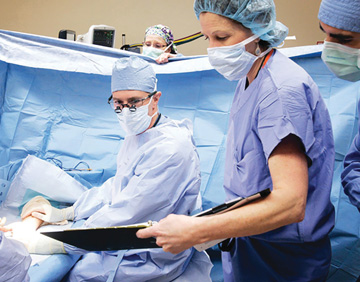• Acknowledge shortcomings. In medicine, we’re less likely to follow protocols with the same regularity – or borderline obsession — that other high-reliability industries do. There are a lot of seemingly
valid excuses and a lot of, “but this is what I’ve always done.” We need to take a page from industries like aviation, nuclear plant operators and amusement parks, and make sure the standard operating procedures we institute
are carried out all the time. Be more compulsive and resist the temptation become relaxed and complacent about safety threats that rarely ever occur.
• Flatten the hierarchies. Check that surgical teams are running ORs in a way in which all comments are welcome. Team leaders must assure that all members of the OR team feel that their participation in the operation is key
to the success of the procedure. It’s not enough to assume that everyone is free to speak. In a true culture of safety, every team member owns part of the operation, and feels that his or her participation is vital. This is when flattening
hierarchies becomes an art, not just a statement. A common way I used to induce medical students to participate more actively in an operation was to tell them that while observing and helping they have to feel that they fully understand and
agree with what the surgeon is doing. If there is something they do not understand, they have the obligation to say so because that means one of only two things can be happening: Either the student does not have enough knowledge about that
part of the procedure, in which case this gives the surgeon the opportunity to teach, or the surgeon is distracted and actually making a mistake and the question at that time prompts the surgeon to correct the error. Questions from team members
should always be encouraged. It keeps the team focus on what they are doing. One should always be careful on how to handle questions, particularly if an answer cannot be provided at a crucial time of the operation.
• Eliminate distractions. There should be as much emphasis on not talking about what you’re not doing as there is on talking about the case at hand. Regularly remind staff to avoid any extraneous conversations about
the movie they saw last week, facility gossip or who’s leaving or starting a new job there. Putting pre-op images up on video monitors for the entire team also helps. In addition to orienting everyone to what will be done, and on what
part of the body it will be performed, it’s also an opportunity to humanize the patient and briefly discuss their medical history, what you’ll be doing to solve their current problem and what issues might be particular to them.
This simple act also increases the likelihood of a team member saying, “No, it’s not supposed to be the right knee, it’s the left.”
• Communicate clearly. Surgeons should always communicate when they’re going to divert from their normal operations. When I was performing a lot of stomach procedures, I would usually do a total plication, but sometimes
I would do a partial plication. If I don’t communicate that subtle change, team members could feel intimidated and not speak up if they thought I was going to do it a different way. They assume I know what I’m doing, and 95% of
the time, they’re right. But the patient needs staff to speak up for the five percent of the time I might be distracted — or even wrong.
By minimizing the threats of human errors, you’ll significantly decrease the number of mistakes you’re capable of making. None of us are immune to these threats, so we need to rely on the abundant safeguards at our disposal with intention.
OSM
.svg?sfvrsn=be606e78_3)

.svg?sfvrsn=56b2f850_5)